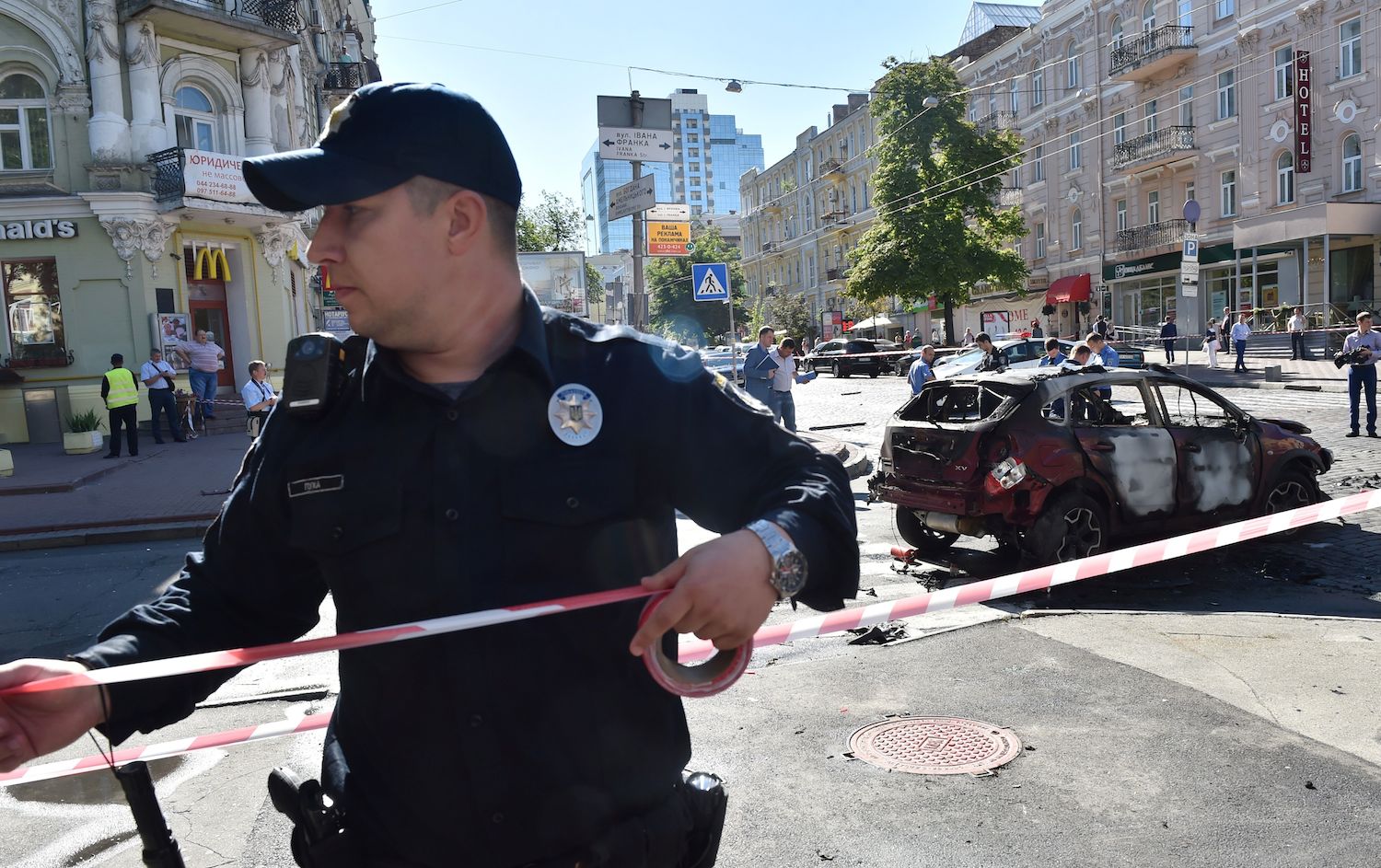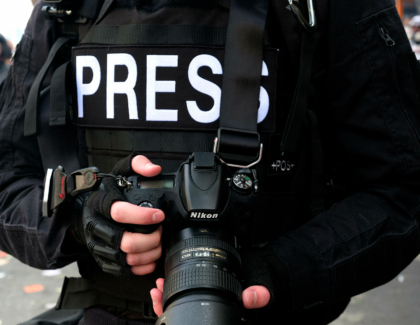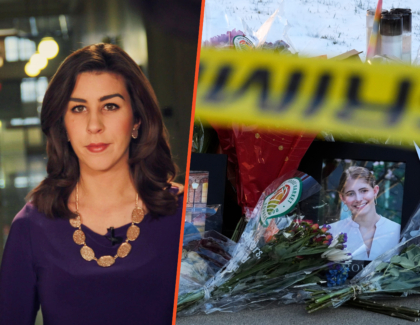Sign up for the daily CJR newsletter.
On the morning of July 20, 2016, Ukrainian journalist Pavel Sheremet left his apartment in central Kiev, stepped into his car, and began his morning commute. Security footage from that day shows Sheremet, in a red Subaru, inching toward an intersection. Suddenly, the car jerks back as a fiery explosion rips through the front seats.
Sheremet was one of 48 journalists killed last year, according to the Committee to Protect Journalists. His death made news around the world, and Ukraine’s president, Petro Poroshenko, promised that authorities would find those responsible.
Nearly a year later, following a police investigation riddled with errors, no one has been held accountable. Meanwhile, Sheremet’s fellow journalists have stepped into the void.
RELATED: The death of a journalist ignored by major outlets
Minutes after Sheremet’s car burst into flames, his Ukrainian colleagues sprang into action, interviewing witnesses and gathering security video from businesses and residences in the area. Together with the Organized Crime and Corruption Reporting Project (OCCRP), an international consortium of investigative journalists, and Slidstvo.info, an online television network, they produced Killing Pavel, a documentary that exposes flaws in the official account of the murder. The film brings the local knowledge of Sheremet’s Ukrainian colleagues together with the resources and technological expertise of journalists across Europe to illuminate the hours leading up to the bombing, and raises questions about the possible complicity of the Security Service of Ukraine, the country’s domestic intelligence agency.
In addition to his work in print and radio, Sheremet served as a mentor to Ukrainian journalists. He organized conferences and workshops that brought reporters, editors, and experts from around the world to Ukraine to speak with local journalists. Born in the former Soviet Union, in what is now Belarus, Sheremet worked as a journalist in his native country before moving to Moscow, where he became a fierce critic of the Kremlin. He later left Russia for Ukraine, where he hosted a morning radio show and wrote for Ukrainska Pravda, an online news outlet. The Committee to Protect Journalists recognized Sheremet with an International Press Freedom award in 1998.
Given his history as a critic of the Lukashenko and Putin governments, as well as the complex politics of a region thrown into chaos by Russia’s annexation of Crimea, many wondered who was responsible for Sheremet’s murder. He had supported the 2014 uprising that forced Viktor Yanukovych from the Ukrainian presidency, but had also been critical of some policies enacted by the new government.
“We still don’t know why he was killed,” says Anna Babinets, OCCRP Ukrainian editor and one of the lead reporters on the documentary. “It’s a mystery for us. We knew Pavel was a Russian and Belarusian journalist before he was a Ukrainian journalist. It was a complicated situation. For us, it was very important to understand for what he was killed.”
Over the course of 10 months, Babinets and her colleagues collected and reviewed closed-circuit video footage, created a detailed map of the path the suspected bombers traveled, tracked down previously unknown witnesses, and interviewed Igor Ustimenko, who was employed by the Security Service of Ukraine, known as the SBU, until at least 2014, and was seen on camera near the scene when the bomb was planted. In an appropriate tribute to a journalist with roots in three countries, the effort marked the first time a major transnational consortium has come together for the express purpose of investigating a journalist’s murder. Versions of the documentary have been produced with Ukrainian, Russian, and English narrations, and the journalists behind it hope that it will both serve as a record of their investigations and keep pressure on authorities to pursue the case with vigor.
The only way to protect ourselves as journalists is to investigate it by ourselves. If we do not do anything with cases like this, it can make bigger dangers for us.”
Babinets, who worked on the Panama Papers project and the YanukovychLeaks investigation, tells CJR there was a personal aspect to the investigation. “I feel that I wanted, and I still want, to work with it because he was a journalist, because it’s about us,” she says. “The only way to protect ourselves as journalists is to investigate it by ourselves. If we do not do anything with cases like this, it can make bigger dangers for us. When we investigate, it’s protection for us, too.”
“There’s a scattered but proud tradition of journalists investigating attacks on our own,” says Bruce Shapiro, executive director of the Dart Center for Journalism and Trauma. For those steeped in investigative journalism’s history, Sheremet’s murder, and the way journalists rallied to respond, calls to mind the car bombing of Arizona Republic reporter Don Bolles. On June 2, 1976, Bolles returned to his blue Datsun after a meeting with a source fell through, and started the car. Moments later, six sticks of dynamite exploded beneath him, mortally wounding the veteran crime reporter.
As Bolles lay clinging to life in a hospital bed, his colleagues at the Republic joined forces with the newly formed Investigative Reporters and Editors (IRE) to pursue those responsible. Bolles died 11 days after the bombing, but reporting by IRE members resulted in the arrests and ultimate convictions of several men with organized crime connections who were implicated in the killing.
ICYMI: What a hyperlocal investigative powerhouse looks like
More recently, journalists from across the western United States came together in 2007 to form the Chauncey Bailey Project after Bailey, the editor in chief of The Oakland Post in California, was assassinated while reporting on corruption at a local bakery. Their reporting likely played a role in the arrest of those responsible for planning Bailey’s murder.
In most of the world, however, the killers of journalists rarely face justice. “When a journalist is killed, every institution of society except for journalists themselves would rather look the other way,” Shapiro says. “The journalist as the enemy is now so much a part of the language of demagogues, and is so much a part of the authoritarian impulse. It’s so pervasive that even in democratic societies there seems to be encouragement for attacks on journalists, and in authoritarian societies impunity has never had it better.”
Ukraine has seen some improvement in its press freedom environment in the years since Poroshenko took office, but the influence of oligarchs and an information war with Russia, as well as the failure of authorities to successfully investigate Sheremet’s murder, have contributed to the country’s ranking of 102 out of 180 nations in the Reporters Without Borders 2017 Press Freedom Index.
“Journalists face huge obstacles in this region,” says Matt Sarnecki, an American journalist based in Romania who is the OCCRP’s video editor and served as writer, producer, and narrator on Killing Pavel. “Whenever a journalist is killed there’s always outrage. It’s what you do for a living. You see all the things that are wrong with it, and you want to right that wrong. If it were a politician who were murdered, I probably wouldn’t have had the same zeal as I had because it was Pavel.”
https://www.gettyimages.com/license/577920454
The work of Babinets, Sarnecki, and their colleagues has led to progress. Ukrainian police have questioned Ustimenko, the former security service employee identified in the documentary. Babinets says the reporters have also reached an agreement with police to share information, allowing journalists access to video footage they were previously unable to obtain. The journalists’ investigation is a sterling example of a collective response to the murder of one of their own.
But Killing Pavel leaves many questions unanswered. What is Igor Ustimenko’s connection to the Security Service of Ukraine? Why did the police miss so many leads that reporters later uncovered? Why, ultimately, was Sheremet killed?
Sarnecki’s narration concludes with a simple statement, “Whether it’s incompetence, or something far worse, the result is the same: Pavel’s killers are still free.”
ICYMI: Reporter posts front pages of LA Times, WashPo & NYTimes. Something was missing.
Has America ever needed a media defender more than now? Help us by joining CJR today.







